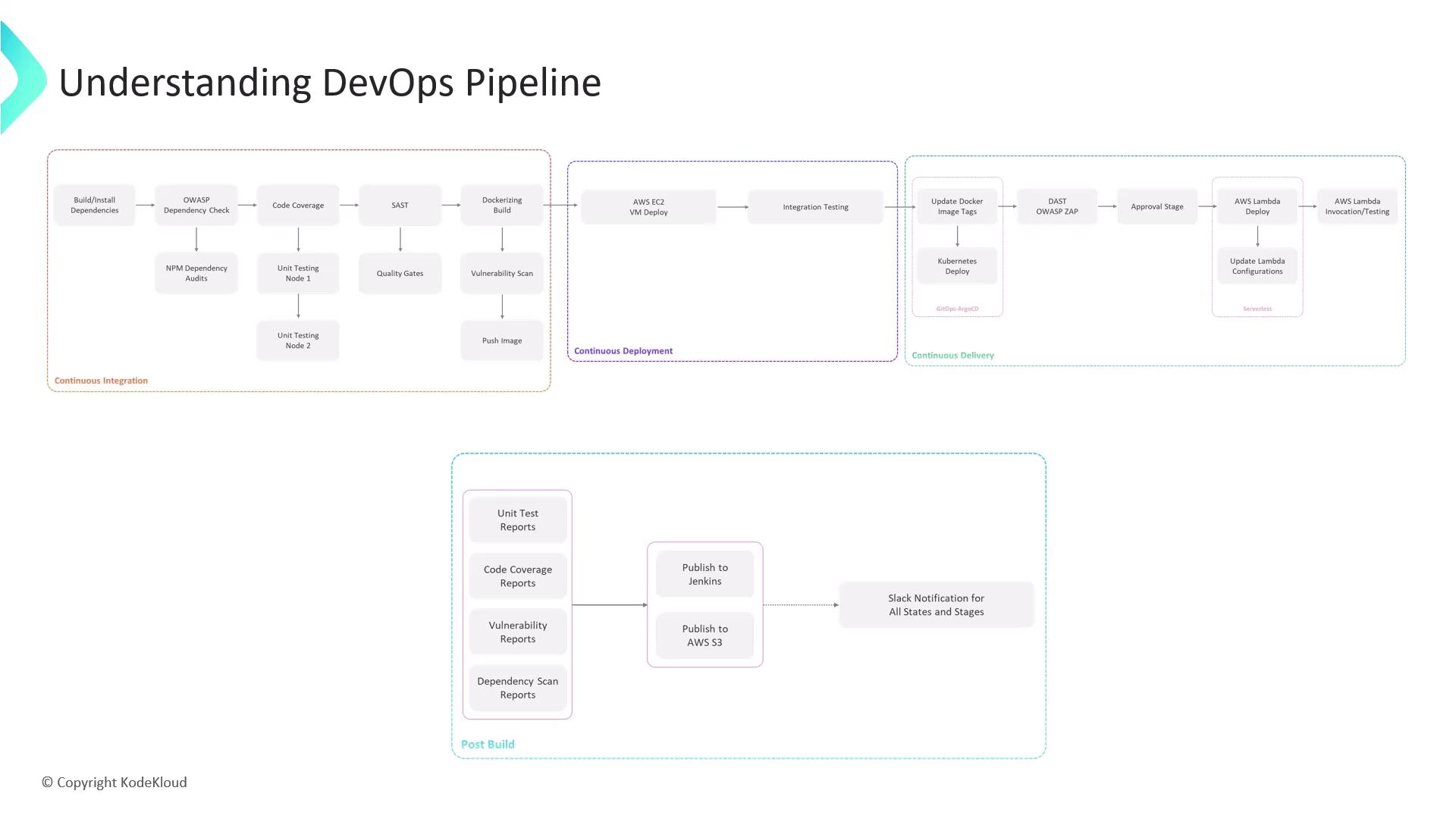Certified Jenkins Engineer
Setting up CI Pipeline
Understanding DevOps Pipeline
In this lesson, we break down a feature-branch DevOps pipeline built with Jenkins, AWS, Docker, Kubernetes, and serverless targets. You’ll see each stage—continuous integration (CI), continuous deployment (CD), continuous delivery, and post-build—and learn how they connect.
DevOps Pipeline at a Glance
| Stage | Objective | Key Tools | Trigger |
|---|---|---|---|
| Continuous Integration | Build, test, and secure code | npm, Jest, SonarCloud, Docker, Snyk | Push to feature branch |
| Continuous Deployment | Deploy container to AWS EC2 | SSH, Docker CLI | Image pushed to registry |
| Continuous Delivery | GitOps-driven rollout to Kubernetes and Lambda | Argo CD, OWASP ZAP, AWS CLI | Pull request creation & merge |
| Post-Build | Collect reports and notify stakeholders | Jenkins archiving, AWS S3, Slack webhook | Completion of all stages |
1. Continuous Integration (CI)
When Jenkins detects a push to a feature branch, it executes the following pipeline. Any failure halts progress early, ensuring only high-quality code advances.

1.1 Install Dependencies
Install Node.js project packages:
npm install
1.2 Dependency Vulnerability Checks
Scan for known vulnerabilities:
npm audit
dependency-check .
1.3 Unit Tests & Coverage
Run unit tests and generate coverage reports:
npm test
npm run coverage
1.4 Static Code Analysis
Analyze code quality with SonarCloud and enforce a quality gate.
Quality Gate Enforced
If the SonarCloud quality gate fails, the Jenkins build is marked as failed. Address all blockers before proceeding.
1.5 Containerization
Package the application into a Docker image:
docker build -t myapp:${BUILD_NUMBER} .
1.6 Image Vulnerability Scan
Use Snyk to scan the container:
snyk container test myapp:${BUILD_NUMBER}
1.7 Push to Container Registry
On success, push the image to your registry (e.g., Docker Hub or AWS ECR):
docker push myregistry/myapp:${BUILD_NUMBER}
2. Continuous Deployment (CD)
Once the image is available in the registry, deploy and test on AWS EC2.
Deploy the Docker container on an EC2 instance:
ssh ec2-user@ec2-instance \ "docker pull myregistry/myapp:${BUILD_NUMBER} && \ docker run -d -p 80:3000 myregistry/myapp:${BUILD_NUMBER}"Execute integration tests to validate endpoints.
Create a pull request (PR) from your feature branch to
main—this triggers the continuous delivery pipeline.
3. Continuous Delivery
A GitOps-driven rollout ensures your changes propagate safely to production-like environments.
- Update Kubernetes manifests with the new image tag.
- Let Argo CD sync the cluster automatically.
- Run Dynamic Application Security Testing (DAST) using OWASP ZAP.
- Peer review and merge the PR.
- A manual approval step in Jenkins authorizes the final deployment.
Manual Approval Required
A designated approver must review security and compliance reports before deploying to production.
- Deploy updated Lambda functions:
aws lambda update-function-code \
--function-name my-function \
--zip-file fileb://function.zip
aws lambda update-function-configuration \
--function-name my-function \
--environment Variables="{KEY=value}"
- Verify the Lambda endpoints:
aws lambda invoke --function-name my-function out.json
4. Post-Build
After deployments complete, gather and publish artifacts:
Archive test results, coverage, and vulnerability reports in Jenkins.
Upload to Amazon S3 for audit and compliance:
aws s3 cp reports/ s3://my-bucket/reports/ --recursiveNotify your team via Slack webhook.
This pipeline showcases Jenkins’ flexibility across EC2, Kubernetes, and Lambda environments, integrating security, testing, and delivery best practices from code commit to production.
Links and References
- Jenkins Documentation
- Docker Official
- AWS CLI Reference
- OWASP Dependency-Check
- SonarCloud
- Snyk
- Argo CD
- OWASP ZAP
Watch Video
Watch video content